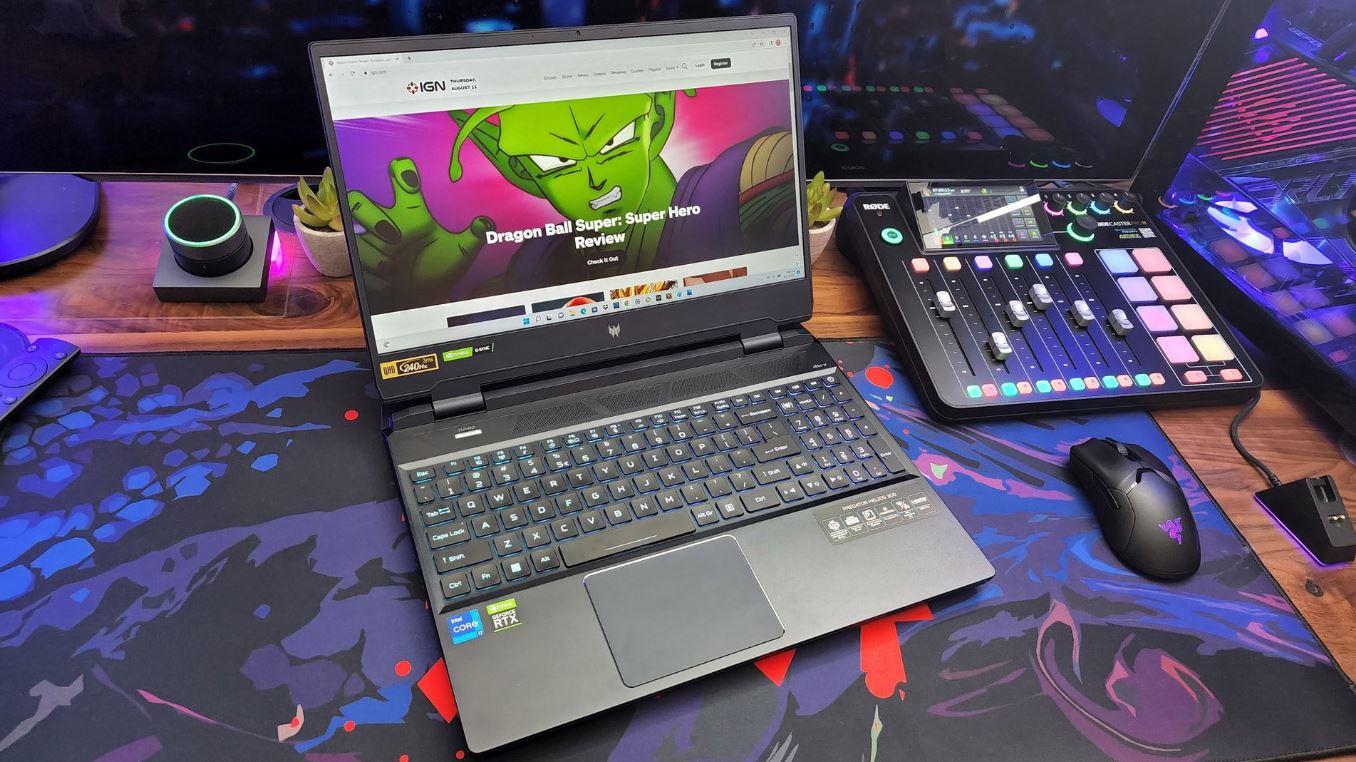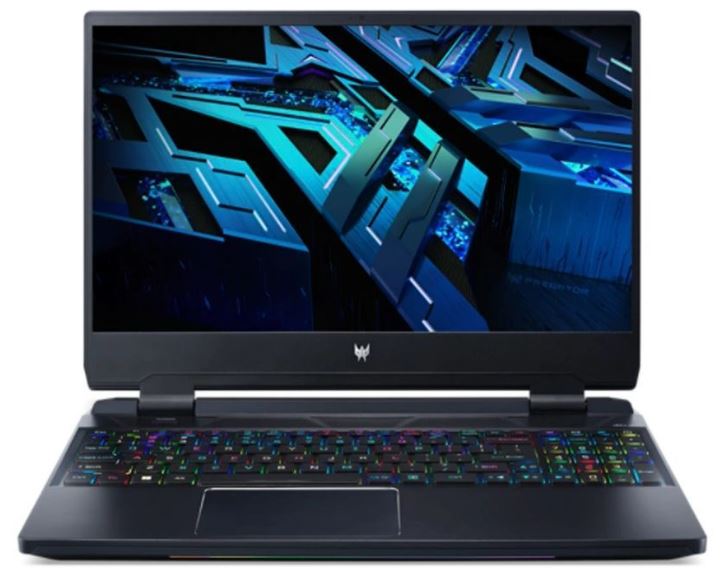
Acer Predator Helios 300 Gaming Laptop
About Acer
Acer is a Taiwanese multinational hardware and electronics corporation that specializes in the production of computer-related products. The company was founded in 1976 and has since become one of the world’s largest computer manufacturers.
Acer produces a wide range of products including desktop and laptop computers, tablets, monitors, projectors, servers, and various accessories. They cater to both the consumer and business markets, offering products that range from budget-friendly options to high-performance devices.
Your guides
To help you use your Predator notebook, we have designed a set of guides:
First off, the Setup Guide helps you get started with setting up your computer.
The Quick Guide introduces you to the basic features and functions of your new computer. For more on how your computer can help you to be more productive, please refer to the User’s Manual. This guide contains detailed information on such subjects as system utilities, data recovery, expansion options, and troubleshooting.
Once you have connected to the internet, you can download updates for your computer from: http://go.acer.com/?id=17883
- The link will open the Predator Service & Support webpage.
- Scroll down to Drivers and Manuals and search for your model by pasting in or manually entering the serial number, SNID, or product model.
- From this page, you can also download and install the Predator identification utility that will automatically detect your computer’s serial number and SNID and allow you to copy it to the clipboard.
- Once you have found your product model, any updates, or documents will be listed.
Visit: Acer Predator Triton 500 SE Gaming Laptop User Guide
Basic care and tips for using your computer
Turning your computer off
To turn the power off, do any of the following:
- Use the Windows shutdown command: Press the Windows key or select the Windows Start button, and select Power > Shut down.
- Right-click the Windows Start button > Shut down or sign out > Shut down.
If you need to power down the computer for a short while, but don’t want to completely shut it down, you can put it to Sleep by doing any of the following:
- Press the power button.
- Press the sleep hotkey.
- Press the Windows key or select the Windows Start button, and select Power > Sleep.
- Right-click the Windows Start button > Shut down or sign out > Sleep.
Taking care of your computer
Your computer will serve you well if you take care of it.
- Only use the adapter provided with your device or an Acer-approved adapter to power your device.
- Do not expose the computer to direct sunlight. Do not place it near sources of heat, such as a radiator.
- Do not expose the computer to temperatures below 0º C (32º F) or above 50º C (122º F).
- Do not subject the computer to magnetic fields.
- Do not expose the computer to rain or moisture.
- Do not spill water or any liquid on the computer.
- Do not subject the computer to heavy shock or vibration.
- Do not expose the computer to dust or dirt.
- Never place objects on top of the computer.
- Do not slam the computer display when you close it.
- Never place the computer on uneven surfaces.
Visit: Acer Predator 8 Gaming Tablet User Manual
Taking care of your AC adapter
Here are some ways to take care of your AC adapter:
- Do not connect the adapter to any other device.
- Do not step on the power cord or place heavy objects on top of it. Route the power cord and any cables away from where people walk.
- When unplugging the power cord, do not pull on the cord itself but pull on the plug.
- The total ampere ratings of the equipment plugged in should not exceed the ampere rating of the cord if you are using an extension cord. Also, the total current rating of all equipment plugged into a single wall outlet should not exceed the fuse rating.
Cleaning and servicing
When cleaning the computer, follow these steps:
- Turn off the computer.
- Disconnect the AC adapter.
- Use a soft, moist cloth. Do not use liquid or aerosol cleaners.
If your computer is dropped or visibly damaged or does not work normally, please contact your nearest authorized Predator service center.
YOUR PREDATOR NOTEBOOK TOUR
After setting up your computer as illustrated in the Setup Guide, let us show you around your new Predator computer.
Screen view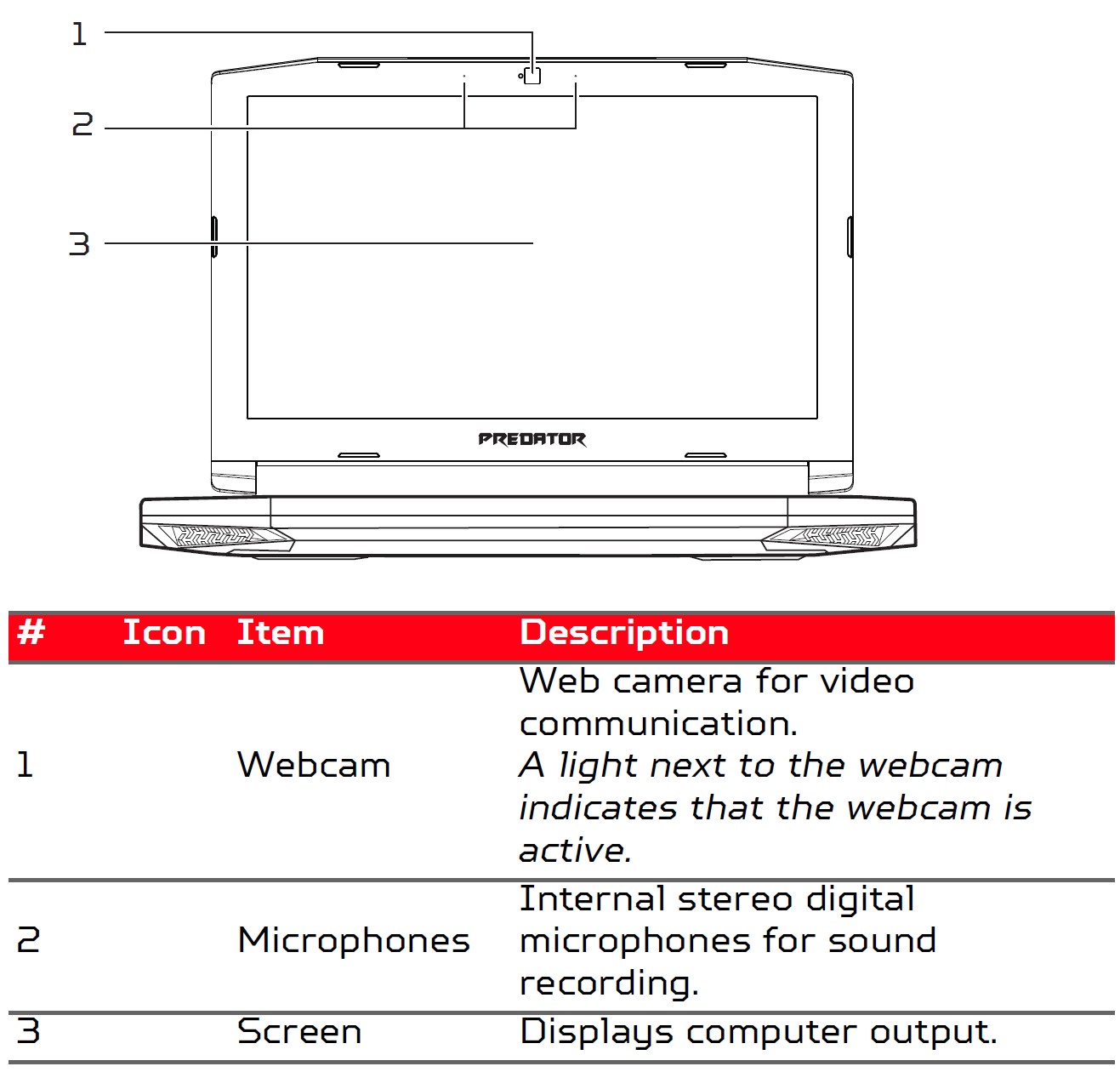
Keyboard view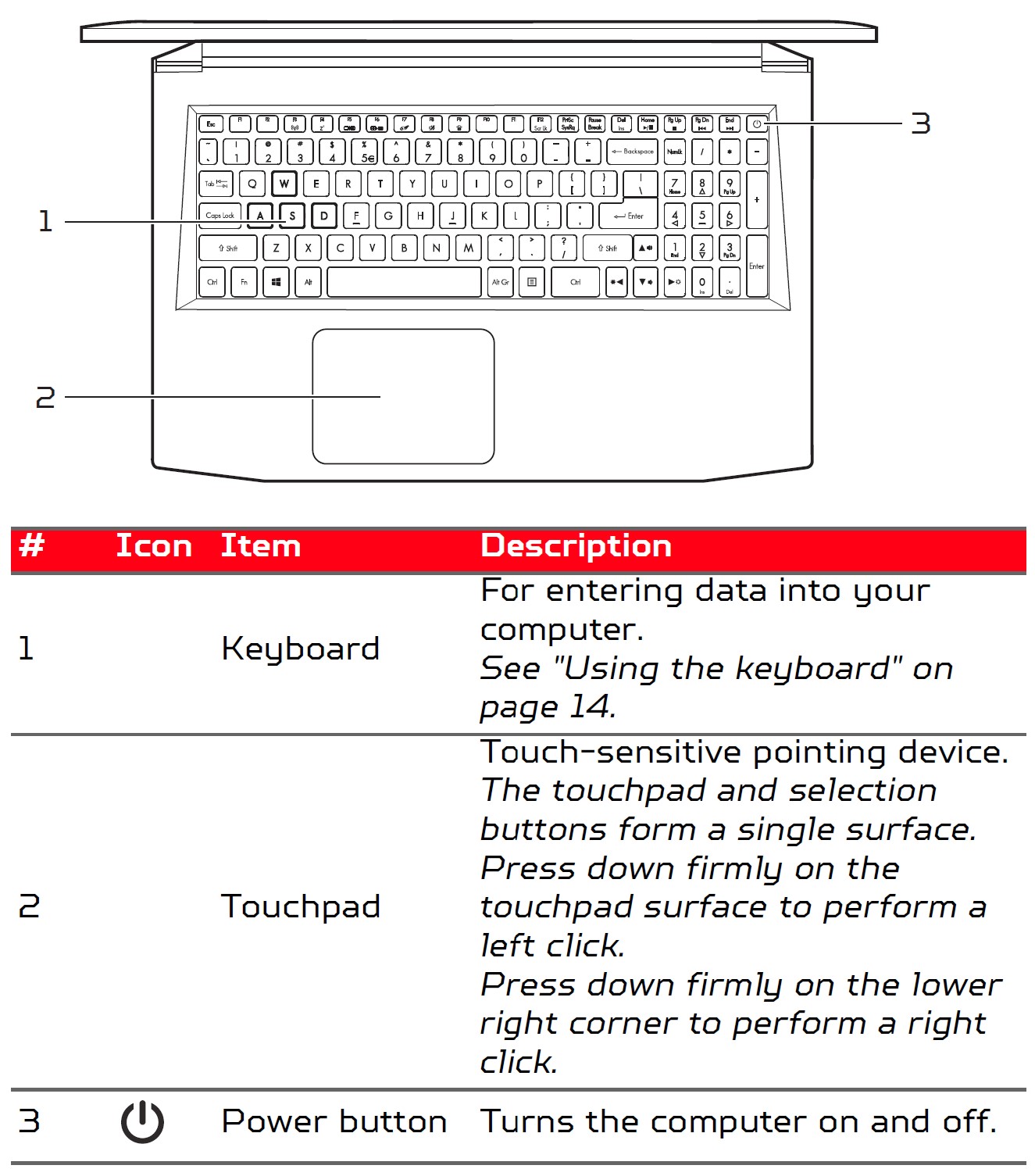
Left view
USB Type-C information
- USB 3.1 Gen 1 with transfer speeds up to 5 Gbps.
- Delivers up to 3 A at 5 V DC for USB charging.
USB 3.0 information
- USB 3.0 compatible ports are blue.
- Compatible with USB 3.0 and earlier devices.
- For optimal performance, use USB 3.0-certified devices.
- Defined by the USB 3.0 specification (SuperSpeed USB).
Right view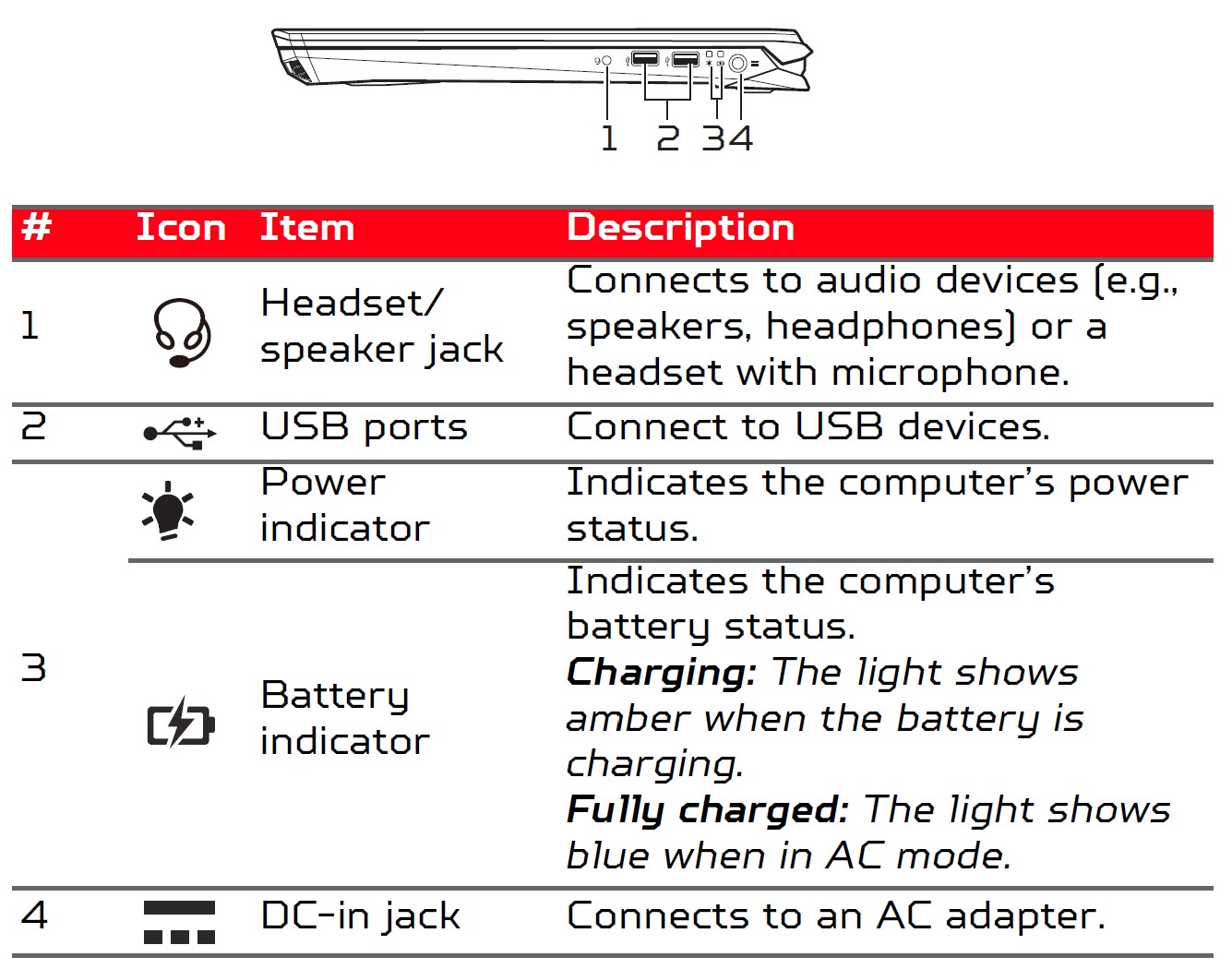
Visit: Acer Aspire 5 Windows Laptop User Manual
Rearview
Base view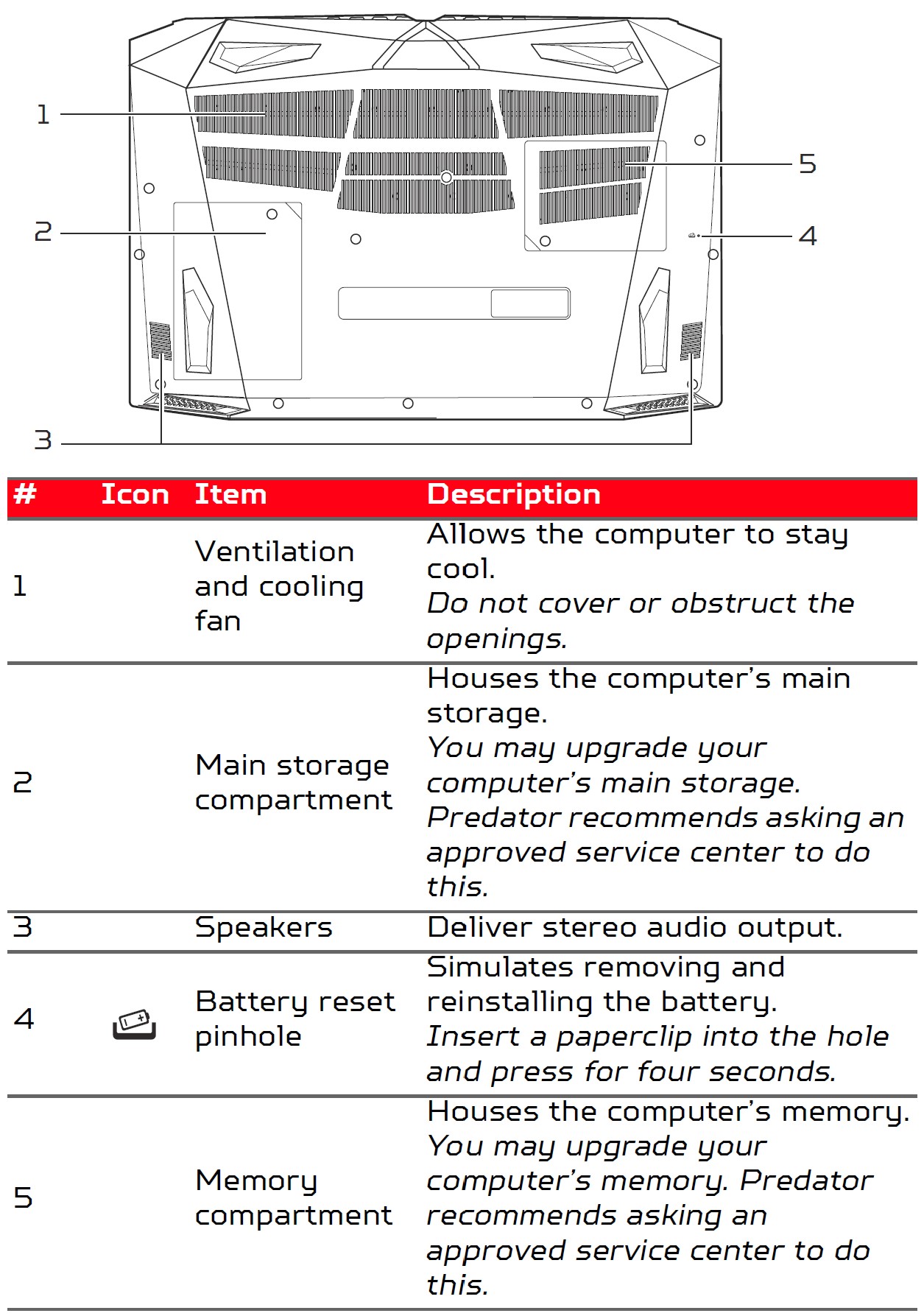
USING THE KEYBOARD
The keyboard has full-sized keys and a separate numeric keypad, separate cursor, lock, Windows, function, and special keys.
Visit: Lenovo ThinkPad E555 Laptop User Manual
Lock keys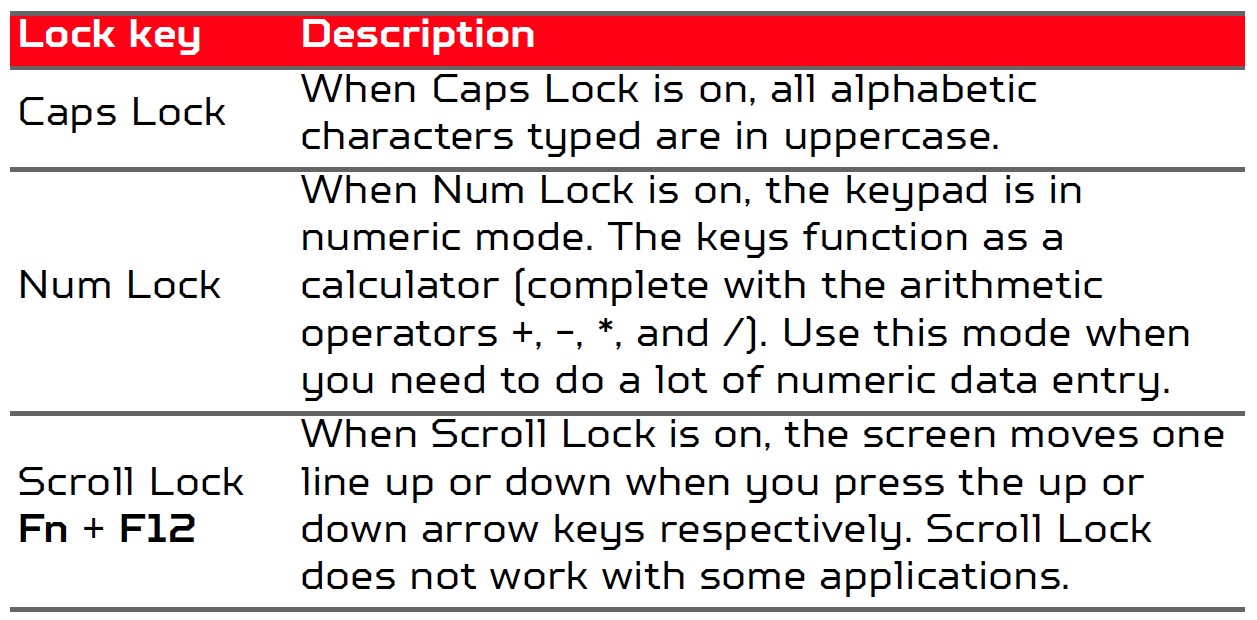
Hotkeys
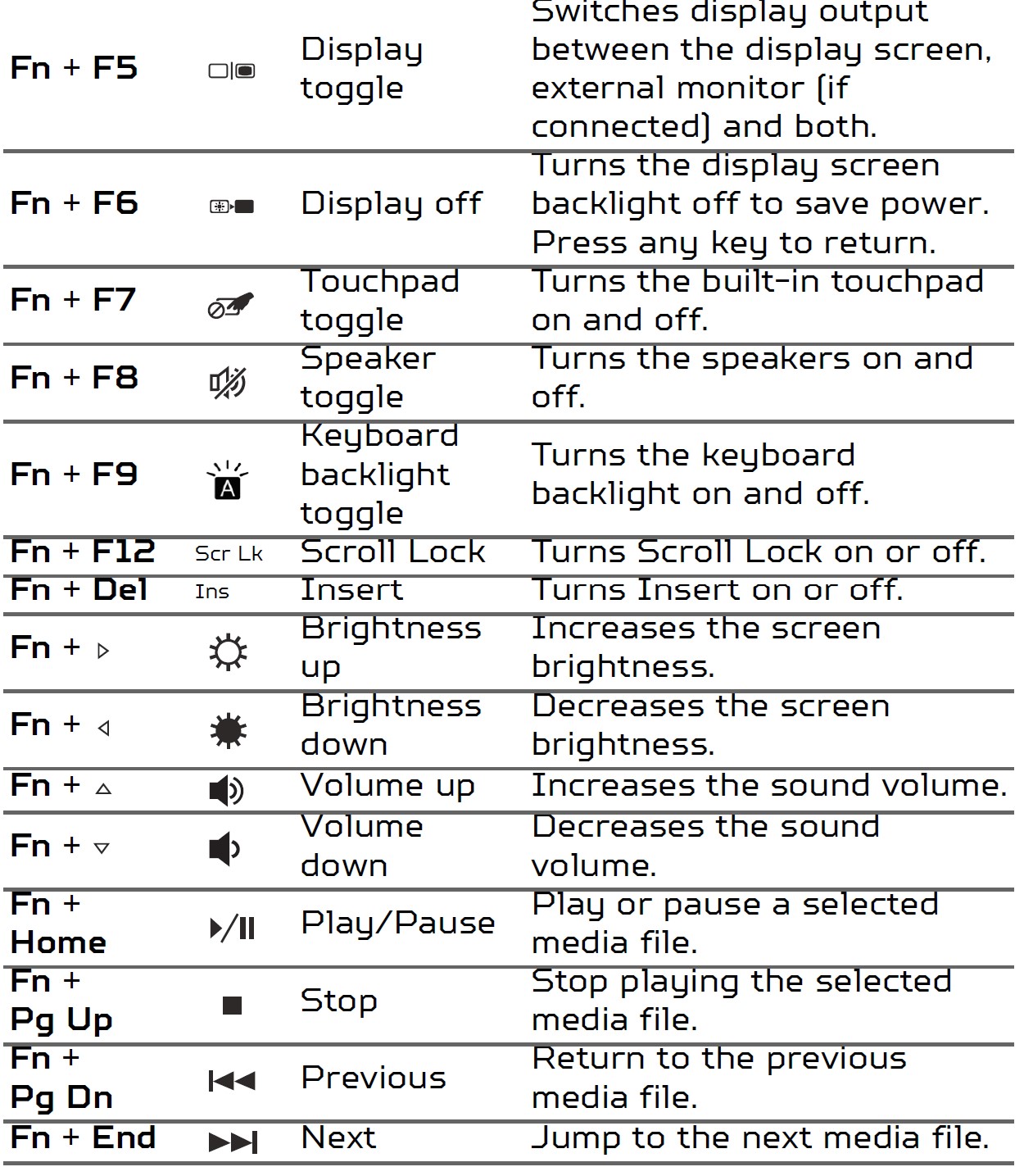
Windows keys
The keyboard has two keys that perform Windows-specific functions.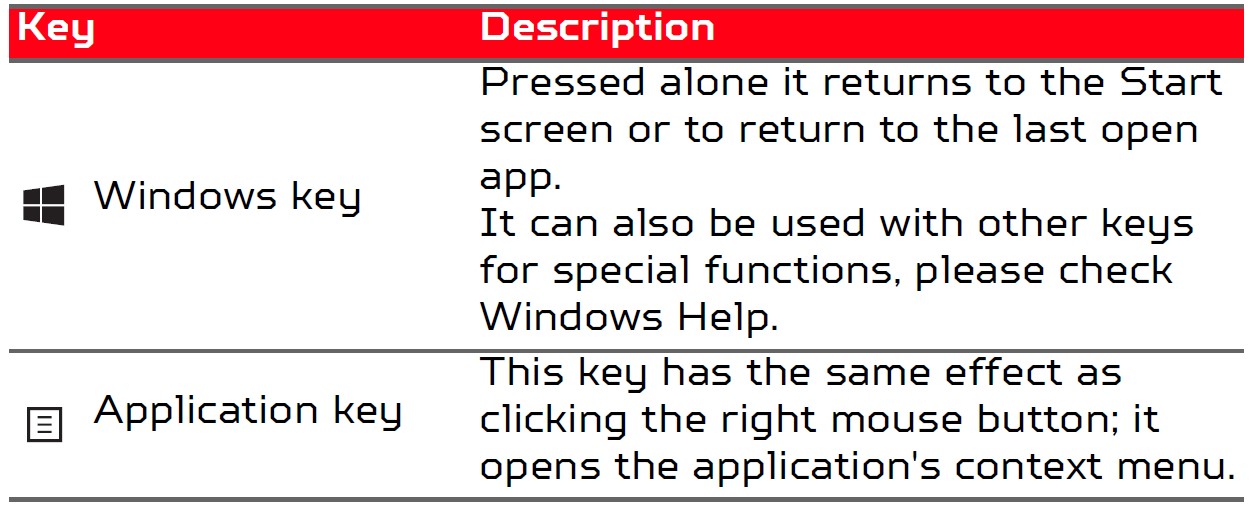
Visit: Dell Inspiron 15 5000 Series Laptop Service Manual
RECOVERY
If you are having trouble with your computer, and the frequently asked questions do not help, you can recover your computer.
This section describes the recovery tools available on your computer. Predator provides Acer Care Center, which allows you to reset your PC, refresh your PC, or create a factory default backup.
Note: Acer Care Center is only available with a pre-installed Windows operating system.
Important: We recommend that you create a Factory Default Backup as soon as possible. In certain situations, a full recovery will require a USB recovery backup.
Creating a factory default backup
Backup allows you to quickly and easily back up your operating system, installed apps, and data.
- From Start, select All apps then Predator. Select Predator Recovery Management in the list of Predator apps. Note: Since the recovery backup requires at least 8 GB of storage after formatting, it is recommended to use a USB drive with a capacity of 16 GB or larger.
- Select the Backup tab and click Get Started for Create Factory Default Backup to open the Recovery Drive window.
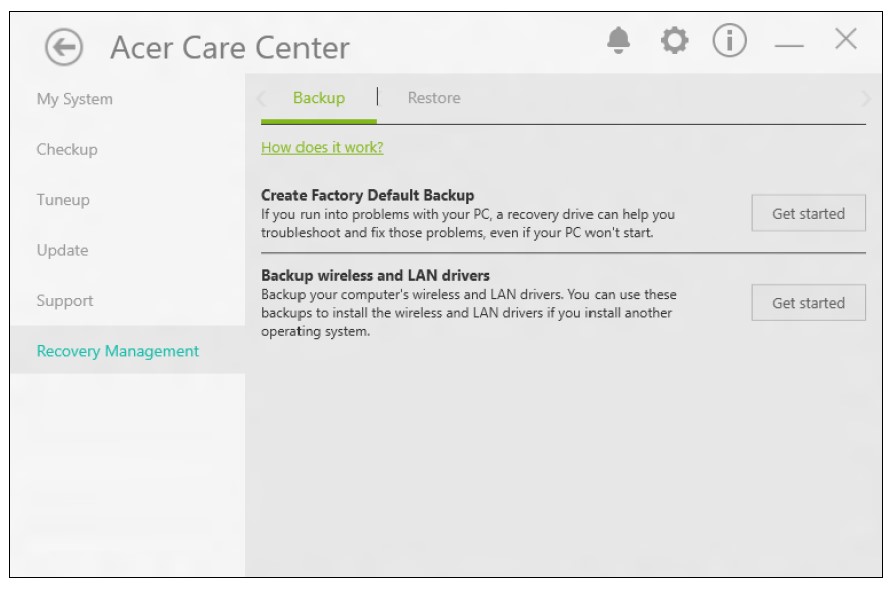
- Make sure the Backup system files to the recovery drive are selected and click Next.
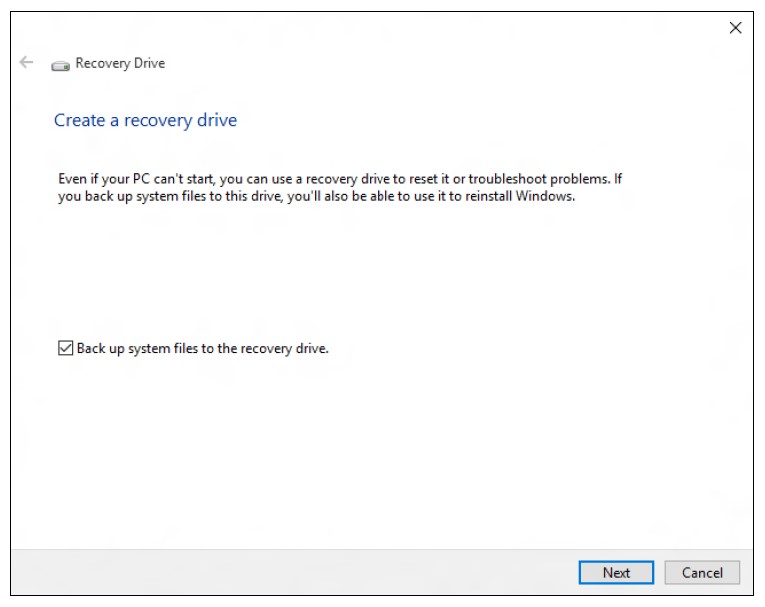
- Plug in the USB drive and wait for the PC to detect the USB drive then click Next.
- Since the recovery backup requires at least 8 GB of storage after formatting, it is recommended to use a USB drive with a capacity of 16 GB or larger.

- Since the recovery backup requires at least 8 GB of storage after formatting, it is recommended to use a USB drive with a capacity of 16 GB or larger.
- Everything on the drive will be deleted. Click Create to continue.
- You will be shown the backup progress on the screen.
- Follow the process until it completes.
- After creating the recovery backup, you can choose to delete the recovery information on your computer. If you delete this information, you can only use the USB recovery backup to restore your computer, if you lose or erase the USB drive, you cannot restore your computer.
- Unplug the USB drive and label it clearly. Important: Write a unique, descriptive label on the backup, such as ‘Windows Recovery Backup’. Make sure you keep the backup in a safe place that you will remember.
Visit: MSI GP72 Leopard Pro-002 Gaming Laptop User Guide
Backing up your wireless and LAN drivers
Back up your wireless and LAN drivers. You can use these backups to install the wireless and LAN drivers if you install another operating system.
- From Start, select All apps then Predator. Select Predator Recovery Management in the list of Predator apps.
- Select the Backup tab and click Get Started for Backup Wireless and LAN drivers. Choose a folder to save your drivers and select OK.
Restoring your computer
Recovery Management allows you to quickly and easily restore your computer back to its default status. You can choose to keep your files or remove them before reinstalling Windows.
Visit: MSI PX60 Prestige GTX 950M Laptop User Manual
Reset this PC and keep my files
- From Start, select All apps then Predator. Select Predator Recovery Management in the list of Predator apps.
- Select the Restore tab and click Get Started to Choose an option.

- Select Keep my files to refresh your PC and reinstall your operating system without removing your personal files. Click Next to continue.
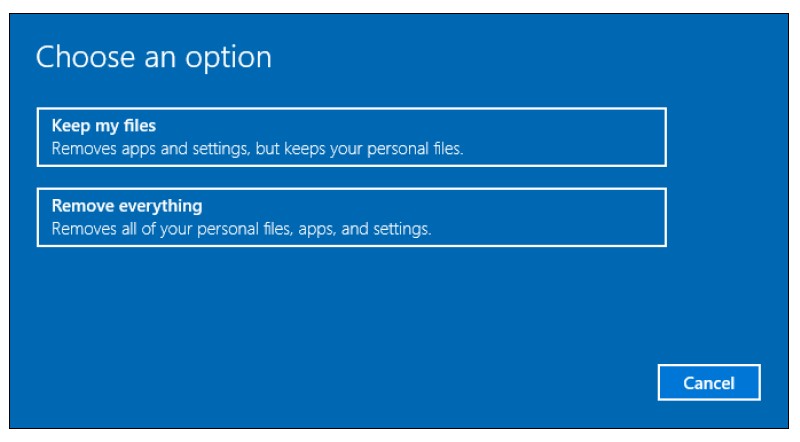 Important: If you have apps installed on your PC, they will be removed.
Important: If you have apps installed on your PC, they will be removed. - Resetting the PC will reinstall Windows, change settings back to their factory defaults, and remove all preinstalled apps and programs without removing your personal files. Click Reset to continue.
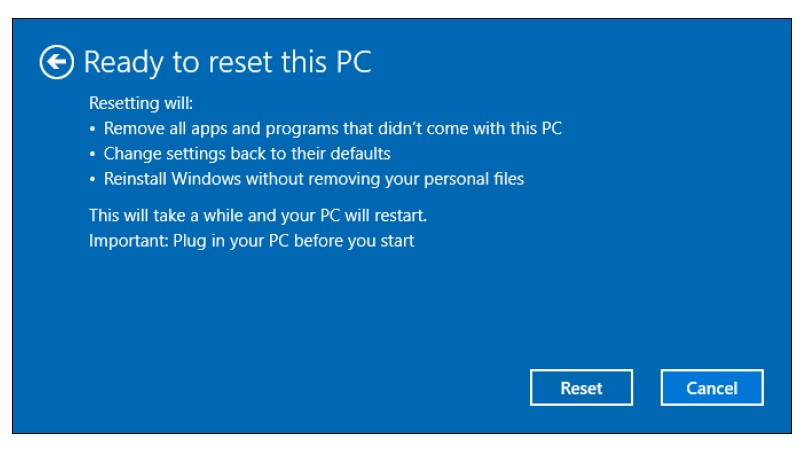
- You will be shown the reset progress on the screen. The screen will turn off during the reset process.
- The screen will turn back on when it is installed in Windows. Your PC will restart several times during the reset process.
- Follow the process until it completes.
- When your PC has completed the reset process, Windows will have been reset back to its factory default settings without removing your personal files.
Visit: MSI PX60 Prestige GTX 950M Laptop User Manual
Reset this PC and remove everything
- From Start, select All apps then Predator. Select Predator Recovery Management in the list of Predator apps.
- Select the Restore tab and click Get Started to Choose an option.
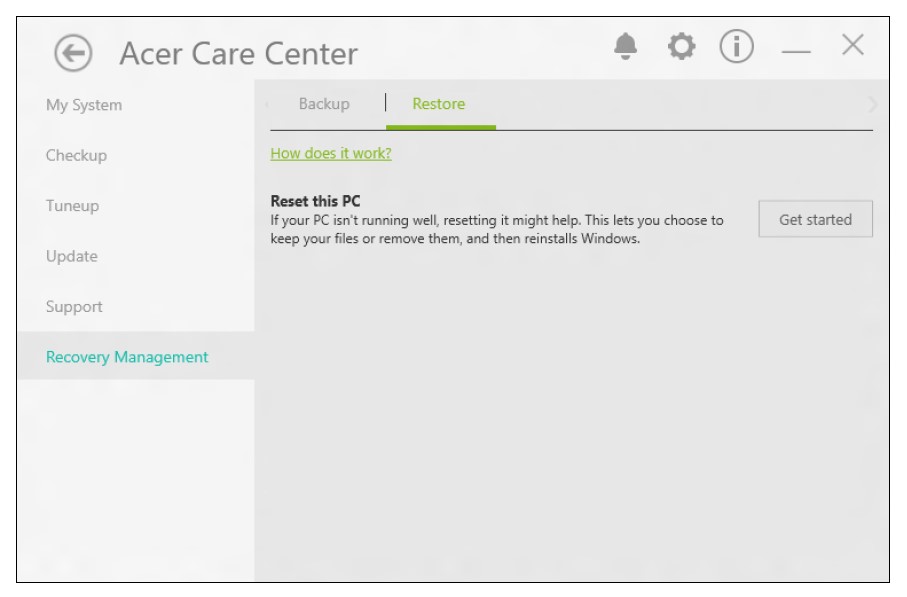
- Select Remove Everything to reset your PC back to its factory default. This process will reinstall your operating system and remove all of your personal files, apps, and settings.
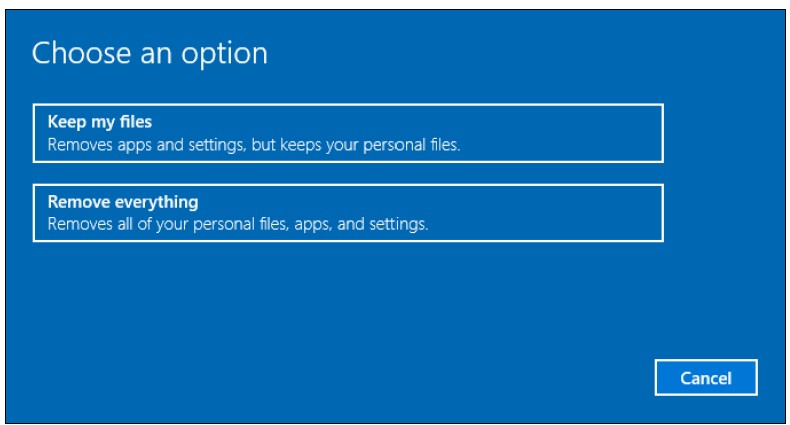
- Select Just remove my files if you are keeping your computer. This will be quicker, but less secure. Files may still be recovered with a file recovery program. Select Remove files and clean the drive if you are not keeping your computer. This process will take longer but will be more secure.
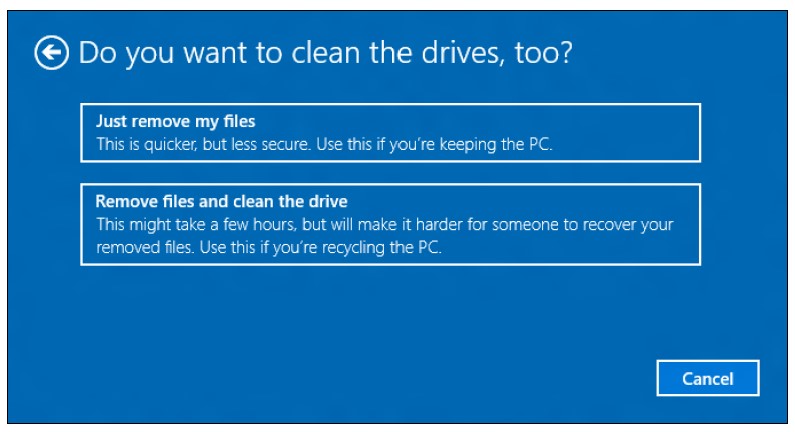 Warning: Selecting “Remove files and clean the drive” will remove all of your personal files and accounts, along with pre-existing drivers that may affect your Windows installation.
Warning: Selecting “Remove files and clean the drive” will remove all of your personal files and accounts, along with pre-existing drivers that may affect your Windows installation. - Click Reset to continue.
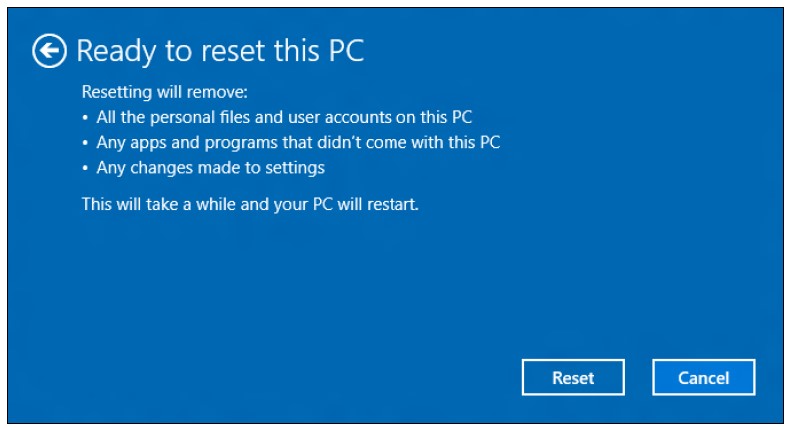
- You will be shown the reset progress on the screen. The screen will turn off during the reset process.
- The screen will turn back on when it is installed in Windows. Your PC will restart several times during the reset process.
- Follow the process until it completes.
- When your PC has completed the reset process, Windows will use factory default settings.
SECURING YOUR COMPUTER
Your computer is a valuable investment that you need to take care of. Learn how to protect and take care of your computer.
Security features include hardware and software locks — a security notch and passwords.
Visit: Microsoft Surface Pro 4 Laptop User Guide
Using a computer security lock
The computer comes with a computer security slot for a security lock.
Wrap a computer security lock cable around an immovable object such as a table or handle of a locked drawer. Insert the lock into the notch and turn the key to secure the lock. Some keyless models are also available.
Using passwords
Passwords protect your computer from unauthorized access. Setting these passwords creates several different levels of protection for your computer and data:
- Supervisor Password prevents unauthorized entry into the BIOS utility. Once set, you must enter this password to gain access to the BIOS utility.
- User Password secures your computer against unauthorized use. Combine the use of this password with password checkpoints on boot-up and resume from Hibernation (if available) for maximum security.
- Password on Boot secures your computer against unauthorized use. Combine the use of this password with password checkpoints on boot-up and resume from Hibernation (if available) for maximum security.
Entering passwords
When a password is set, a password prompt appears in the center of the display screen.
- When the Supervisor Password is set, a prompt appears when you enter the BIOS utility.
- Type the Supervisor Password and press Enter to access the BIOS utility. If you enter the password incorrectly, a warning message appears. Try again and press Enter.
- When the User Password is set and the password on the boot parameter is enabled, a prompt appears at boot-up.
- Type the User Password and press Enter to use the computer. If you enter the password incorrectly, a warning message appears. Try again and press Enter.
Visit: Victus by HP 15 NVIDIA GeForce RTX 3050 Gaming Laptop Datasheet
BIOS UTILITY
The BIOS utility is a hardware configuration program built into your computer’s BIOS.
Your computer is already properly configured and optimized, and you do not normally need to run this utility. However, if you encounter configuration problems, you may need to run it.
To activate the BIOS utility, press F2 while the computer logo is displayed.
Boot sequence
To set the boot sequence in the BIOS utility, activate the BIOS utility, then select Boot from the categories listed on the left of the screen.
Setting passwords
To set a password on boot, activate the BIOS utility, then select Security from the categories listed on the left of the screen.
Find Set Supervisor Password and enter a password to enable this feature. Once you have entered a password for this feature, you may then enable/disable Password on Boot.
Remember to select F10 to properly save and exit the BIOS utility when you are done making changes.
POWER MANAGEMENT
This computer has a built-in power management unit that monitors system activity. System activity refers to any activity involving one or more of the following devices: keyboard, mouse, hard disk, peripherals connected to the computer, and video memory. If no activity is detected for a period of time, the computer stops some or all of these devices in order to conserve energy.
Visit: MSI GS70 Stealth Pro-006 Gaming Laptop Notebook User Manual
Saving power
Disable Fast startup
Your computer uses Fast Startup to start quickly but also uses a small amount of power to check for signals to start. These checks will slowly drain your computer’s battery.
If you prefer to reduce your computer’s power requirements and environmental impact, turn off Fast Startup:
Note: If Fast Startup is off, your computer will take longer to start from Sleep. Your computer will also not start if it receives an instruction to start over a network (Wake on LAN).
- Open the desktop.
- Click Power Options in the Notification area.
- Select More Power Options.
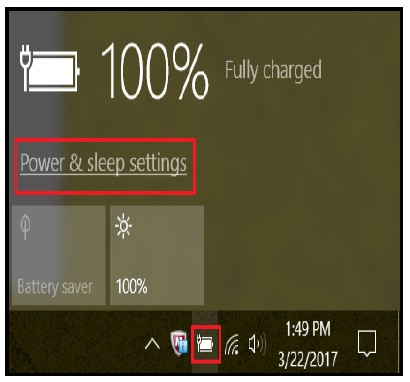
- Select Choose what the power buttons do.
- Select Change settings that are currently unavailable.
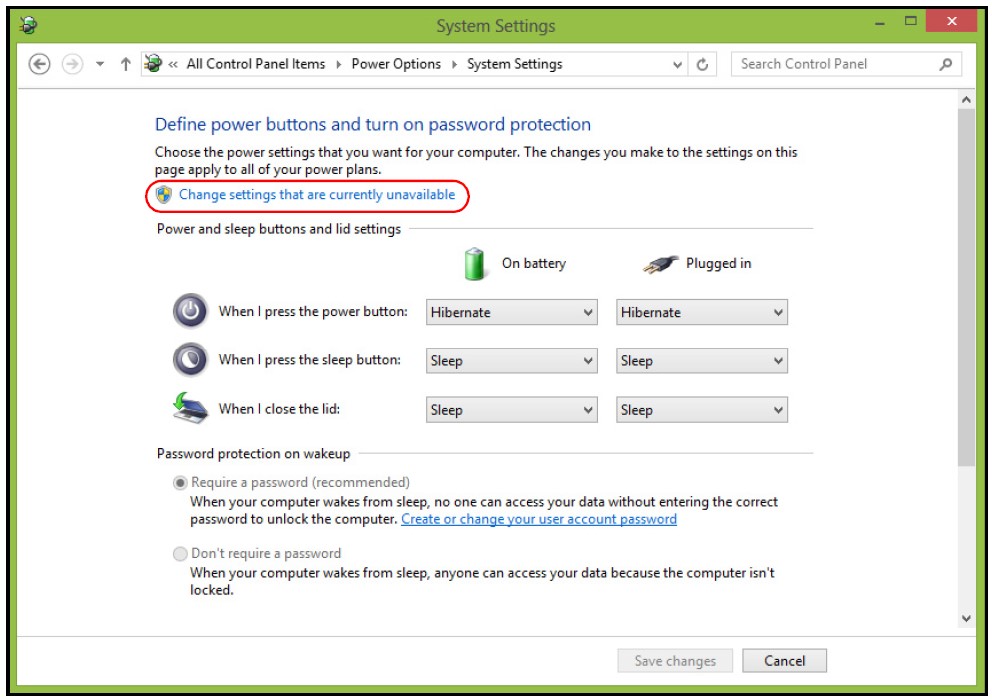
- Scroll down and disable Turn on fast startup.
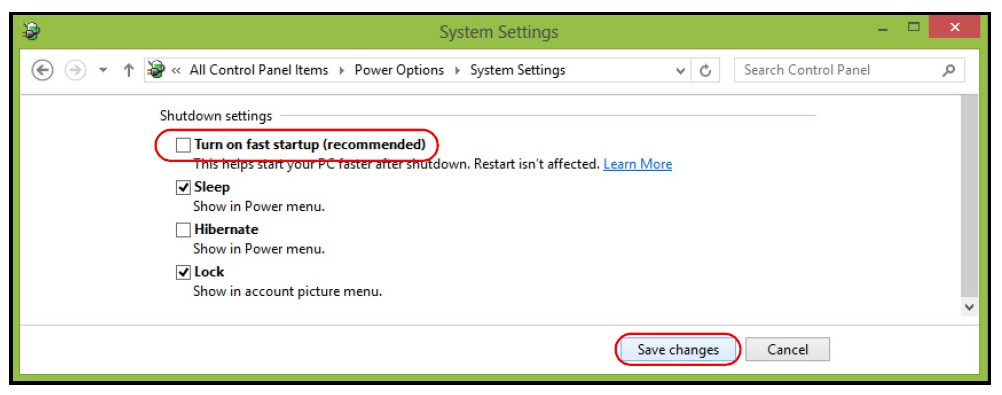
- Select Save Changes.
BATTERY PACK
The computer uses an embedded Lithium battery that gives you long use between charges.
Battery characteristics
The battery is recharged whenever you connect the computer to the AC adapter. Your computer supports charge-in-use, enabling you to recharge the battery while you continue to operate the computer. However, recharging with the computer turned off significantly reduces charge time.
The battery will come in handy when you travel or during a power failure.
Visit: Fujitsu Lifebook E744 Notebook Laptop Operating Manual
Ports and connectors
UNIVERSAL SERIAL BUS (USB)
The USB port is a high-speed port that allows you to connect USB peripherals, such as a mouse, an external keyboard, additional storage (external hard disks), or any other compatible device.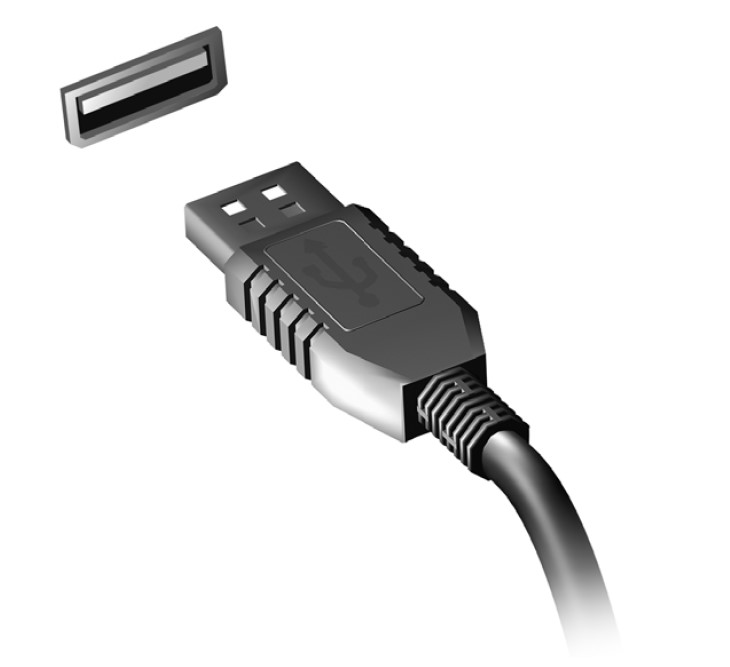
Note: Two USB standards are currently available on Predator computers: USB 2.0 (High-speed USB) and USB 3.0 (SuperSpeed USB). USB 2.0 ports on Predator computers have a black tongue in the port, while USB 3.0 ports have a blue tongue. For best performance, USB 3.0 devices should always be plugged into USB 3.0 ports. Consult your device’s documentation to see which standard it supports.
You can also charge devices such as tablets, smartphones, or other devices through a USB port. Some USB 3.0 ports support charging devices when the computer is in Hibernate or turned off. Additionally, you can use a USB hub to connect multiple devices to a single USB port.
Important: When removing a USB storage device, you should right-click on the USB icon in the Windows taskbar and select “Eject <device>” to tell the operating system to stop using the device before removing it. Failure to do this may result in data loss or damage to your peripheral.
USB TYPE-C PORT
A USB Type-C port is a connector that allows you to easily connect USB Type-C peripherals, such as additional storage (e.g. an external drive), or any other compatible device.
The Type-C port is reversible; connectors may be inserted with either side up.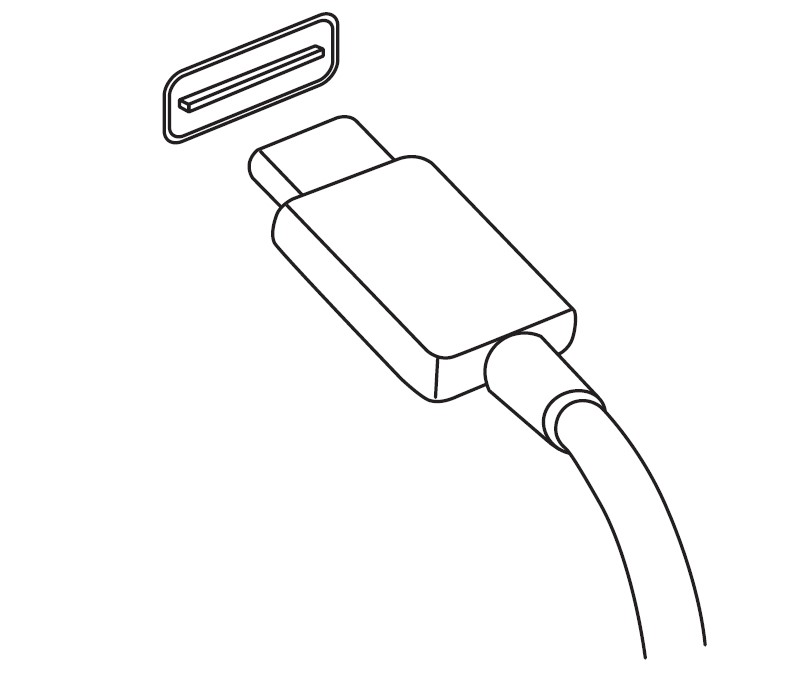
Note: On Acer computers USB Type-C ports support up to USB 3.1 (SuperSpeed USB, 5 Gbps).
Other USB or Thunderbolt devices with a USB Type-C connector are supported, but transfer speed may be reduced and certain functions will be disabled (such as Thunderbolt video support).
Visit: Fujitsu Lifebook E734 Notebook Laptop Operating Manual
Important: When removing a USB storage device, you should right-click on the USB icon in the Windows taskbar and select “Eject <device>” to tell the operating system to stop using the device before removing it. Failure to do this may result in data loss or damage to your peripheral.
SD CARD READER
SD (Secure Digital) cards are used in a wide selection of digital cameras, tablets, media players, and cellular phones.
Inserting an SD card
- Align the card so that the connector points towards the port, with the connectors facing down.
- Carefully slide the card into the port. If you find you need to use any force to insert the card, try reorientating the card slightly.
- Push the card until it clicks into place. A few millimeters of the card will extend from beyond the slot.
If the card contains some files, the Windows AutoPlay window may appear (this depends on the contents of the card) and ask you if you wish to use a program to access the contents of the card.
Important: When removing an SD card, you should right-click on the USB icon in the Windows taskbar and select “Eject <card name>” to tell the operating system to stop using the device before removing it. Failure to do this may result in data loss or damage to your peripheral.
SD, SDHC, and SDXC cards
Different types of SD cards cover different capacities while using the same overall design. SD cards contain up to 4 GB; SDHC cards contain up to 32 GB; and SDXC cards can contain up to 2048 GB (2 TB). Your computer provides an SDHC or SDXC-compatible card reader.
Note: SDXC memory cards can only be used in an SDXC-compatible reader; SD and SDHC cards can be used in either type.
VIDEO AND AUDIO CONNECTORS
Add an external monitor to your computer via a video port. The type of port available depends on your computer’s configuration.
Connecting a monitor
- Check that the computer is powered off and the monitor power switch is turned off.
- Attach the video cable to the monitor port on the computer.
- Connect the monitor power cable and plug it into a properly grounded wall outlet.
- Follow any setup instructions in the monitor’s user guide.
- Turn on the power to the monitor, then the computer.
- The correct resolution and refresh rate should be detected automatically. If necessary, change the display settings used by the computer.
Note: To access the display controls, press the Windows key ( ) + W, type “Display” and then click on Display.
Headphones and microphone one or more 3.5 mm jacks on your computer allow you to connect audio devices.
Use the headphone port to plug in stereo headphones or powered speakers; connecting an audio device to the headphone port disables the built-in speakers.
Use the microphone port to connect an external microphone; connecting a microphone disables the built-in microphone.
Note: Some computers have a single “combo” port that allows you to use single-pin headsets with a built-in microphone. These headsets are most commonly used with smartphones.
Visit: Dell Alienware M17X R3 Mobile Laptop User Manual
HDMI
HDMI (High-Definition Multimedia Interface) is a high-quality, digital audio/video interface. HDMI allows you to connect any compatible digital audio/video source, such as your computer, a set-top box, DVD player, and audio/video receiver to any compatible digital audio and/or video monitor, such as a digital television (DTV) with a single cable.
The single cable keeps everything neat and tidy while ensuring easy connection and the best audio and visual quality.
Troubleshooting
This chapter shows you how to deal with common system problems.
Read it before calling a technician if a problem occurs. Solutions to more serious problems require opening up the computer. Do not attempt to open the computer yourself; contact your dealer or authorized service center for assistance.
Troubleshooting tips
This computer incorporates an advanced design that delivers onscreen error message reports to help you solve problems.
If the system reports an error message or an error symptom occurs, see “Error messages” below. If the problem cannot be resolved, contact your dealer.
Error messages
If you receive an error message, note the message and take corrective action. The following table lists the error messages in alphabetical order together with the recommended course of action.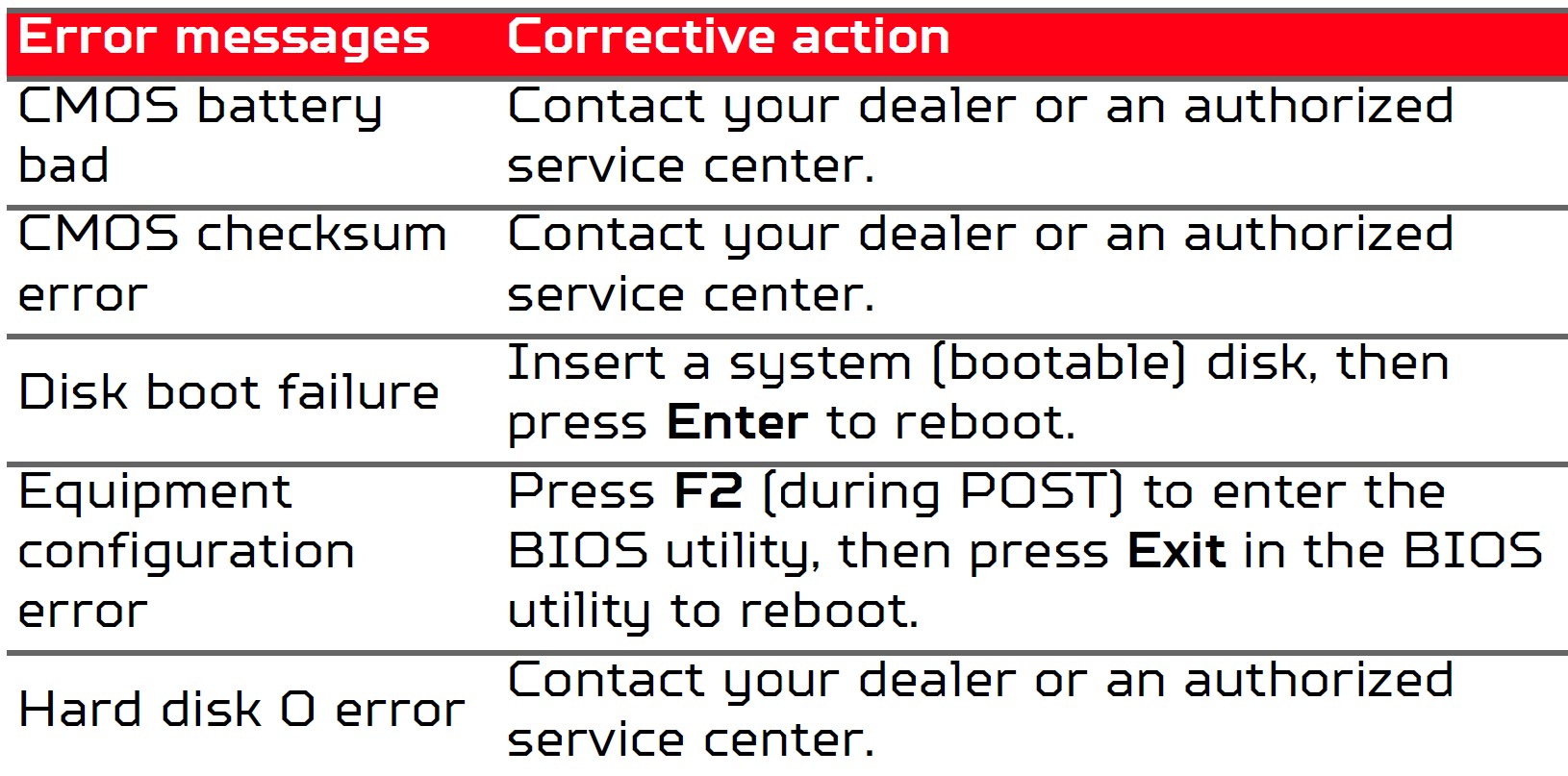
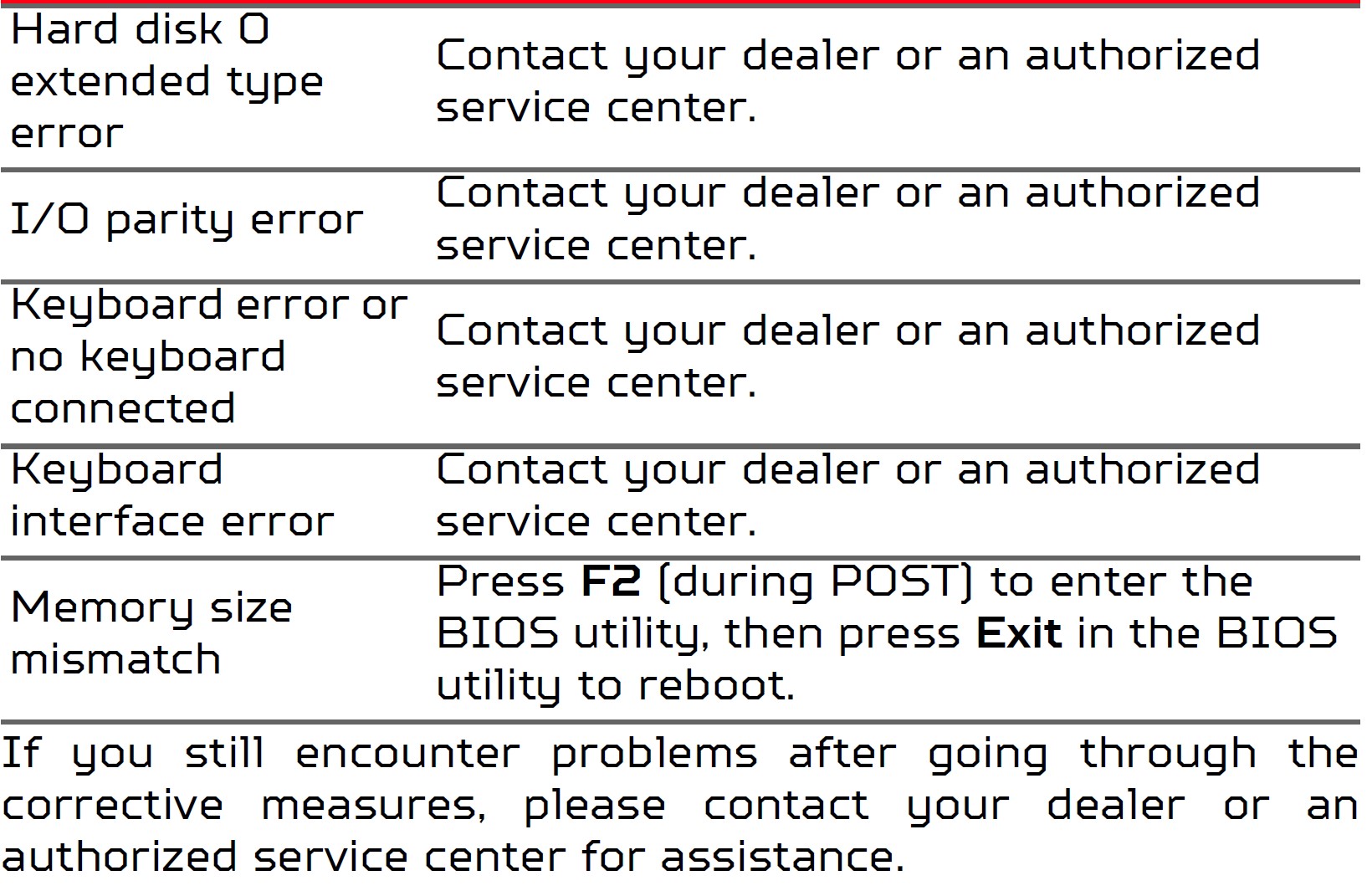
FAQs About Acer Predator Helios 300 Gaming Laptop User Manual
How long does the battery on a predator Helios 300 last?
Battery Life Tested (Hours:Minutes) 7:11
How accurate is the screen on the Acer Predator Helios 300?
Our testing reveal that the Predator Helios panel covers 158% of the sRGB colour gamut and 112.1 percent of the DCI-P3 colour spectrum.
How big is the Helios 300’s screen?
The 15.6-inch Acer Predator Helios 300 screen has a refresh rate of 165 Hz. It offers a crisp 2560 x 1440 resolution.
How can I speed up Predator Helios 300?
Pressing the “Turbo” key above the keyboard or adjusting your settings in the PredatorSense app are the two simple ways to overclock the Predator Helios 300.
Does the Predator Helios 300 resist water?
The gadget can withstand both water and dust. Devices that are water-resistant can withstand water penetration from strong water jets but not being submerged in water.
Helios 300 weighs how much?
Size (kg): 2.7
What is the Predator Helios 300’s refresh rate?
The new Acer Predator Helios 300, which costs Rs. 1,44,999, has an adjustable 360Hz refresh rate display for competitive gamers.
How much RAM is supported by the Acer Predator Helios 300?
32GB
The Predator Helios 300 uses what kind of graphics card?
GeForce RTX 3070 TI from Nvidia
How many fans are there on the Predator Helios 300?
This will swap out any of the laptop’s two fans. Four wires from each fan connect to a four-pin connection.
Can you programme on the Helios 300?
High-end gaming laptop, the Acer Predator Helios 300, also works flawlessly for programming. You can anticipate outstanding outcomes from them.
For more manuals by Acer, Visit Manualsdock

